Organizational Behavior Analysis: Structure, Culture, and Leadership
VerifiedAdded on 2020/01/15
|17
|4397
|158
Report
AI Summary
This report provides a comprehensive overview of organizational behavior, examining the influence of individual behavior, leadership styles, and organizational structure and culture on company performance. It delves into various organizational structures like tall, flat, matrix, shamrock, and network, contrasting their advantages and disadvantages. The report analyzes factors influencing individual behavior, including personality traits and attitudes, and compares leadership styles such as autocratic, democratic, and paternalistic, evaluating their effectiveness. It explores the role of organizational theory, including contingency, classical, and human relations approaches, in management practices. Additionally, the report discusses organizational approaches like scientific management, bureaucratic, and systems approaches, and examines the impact of different leadership styles on motivation during periods of organizational change, including developmental, transitional, and transformational changes. Finally, the report covers the application of motivational theories and the dynamics of group behavior in organizations, including factors promoting team development and the impact of technology on team functioning.
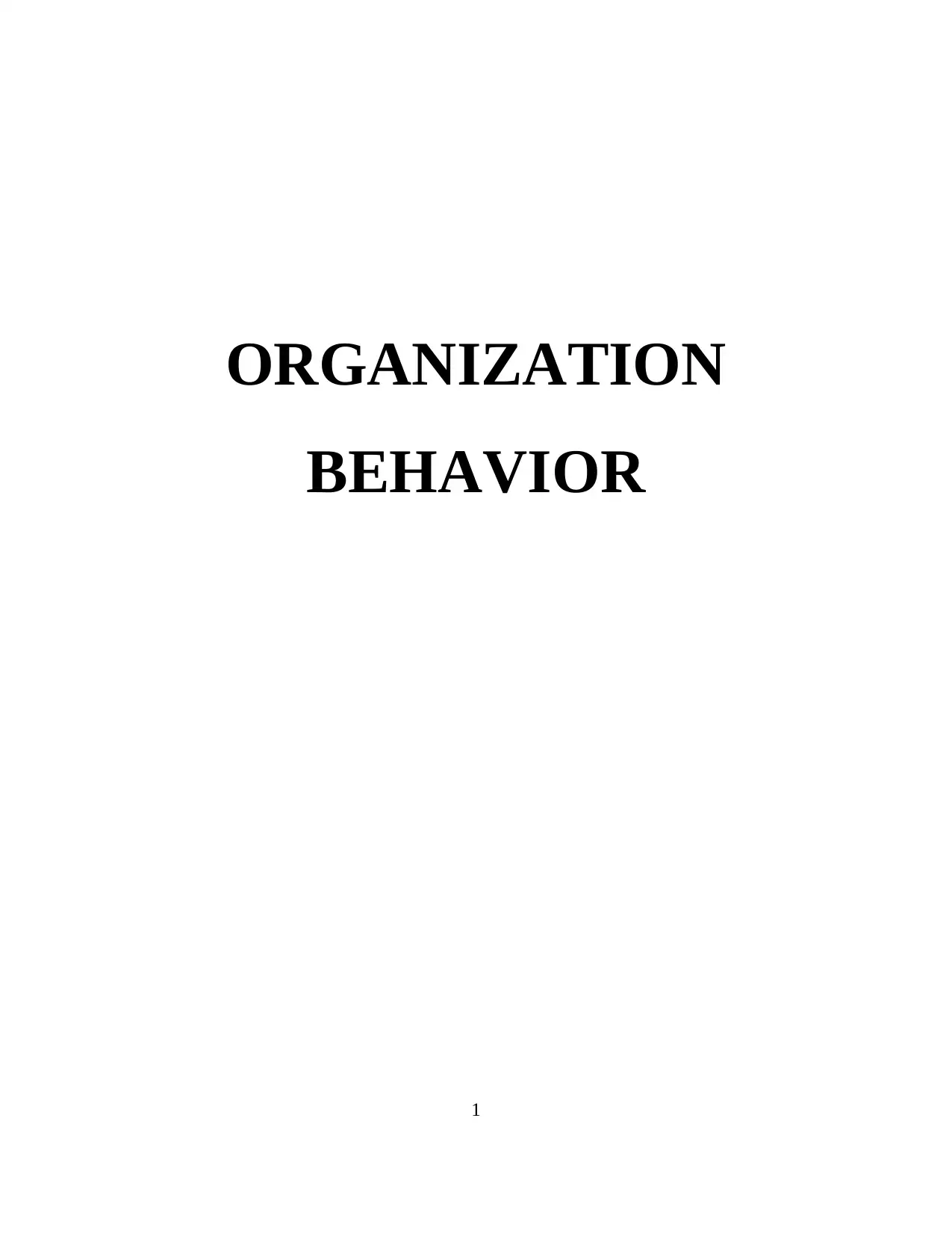
ORGANIZATION
BEHAVIOR
1
BEHAVIOR
1
Paraphrase This Document
Need a fresh take? Get an instant paraphrase of this document with our AI Paraphraser
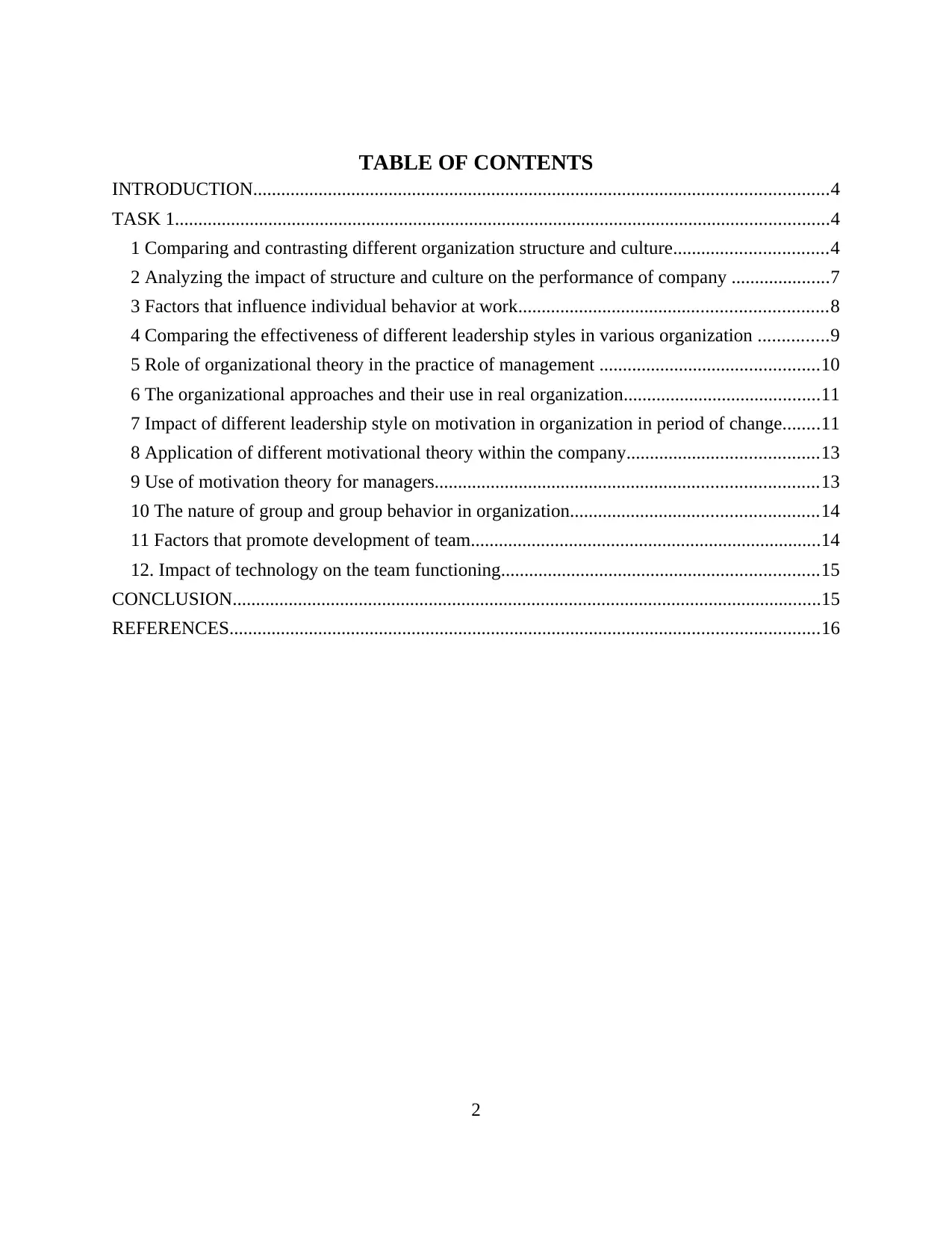
TABLE OF CONTENTS
INTRODUCTION...........................................................................................................................4
TASK 1............................................................................................................................................4
1 Comparing and contrasting different organization structure and culture.................................4
2 Analyzing the impact of structure and culture on the performance of company .....................7
3 Factors that influence individual behavior at work..................................................................8
4 Comparing the effectiveness of different leadership styles in various organization ...............9
5 Role of organizational theory in the practice of management ...............................................10
6 The organizational approaches and their use in real organization..........................................11
7 Impact of different leadership style on motivation in organization in period of change........11
8 Application of different motivational theory within the company.........................................13
9 Use of motivation theory for managers..................................................................................13
10 The nature of group and group behavior in organization.....................................................14
11 Factors that promote development of team...........................................................................14
12. Impact of technology on the team functioning....................................................................15
CONCLUSION..............................................................................................................................15
REFERENCES..............................................................................................................................16
2
INTRODUCTION...........................................................................................................................4
TASK 1............................................................................................................................................4
1 Comparing and contrasting different organization structure and culture.................................4
2 Analyzing the impact of structure and culture on the performance of company .....................7
3 Factors that influence individual behavior at work..................................................................8
4 Comparing the effectiveness of different leadership styles in various organization ...............9
5 Role of organizational theory in the practice of management ...............................................10
6 The organizational approaches and their use in real organization..........................................11
7 Impact of different leadership style on motivation in organization in period of change........11
8 Application of different motivational theory within the company.........................................13
9 Use of motivation theory for managers..................................................................................13
10 The nature of group and group behavior in organization.....................................................14
11 Factors that promote development of team...........................................................................14
12. Impact of technology on the team functioning....................................................................15
CONCLUSION..............................................................................................................................15
REFERENCES..............................................................................................................................16
2
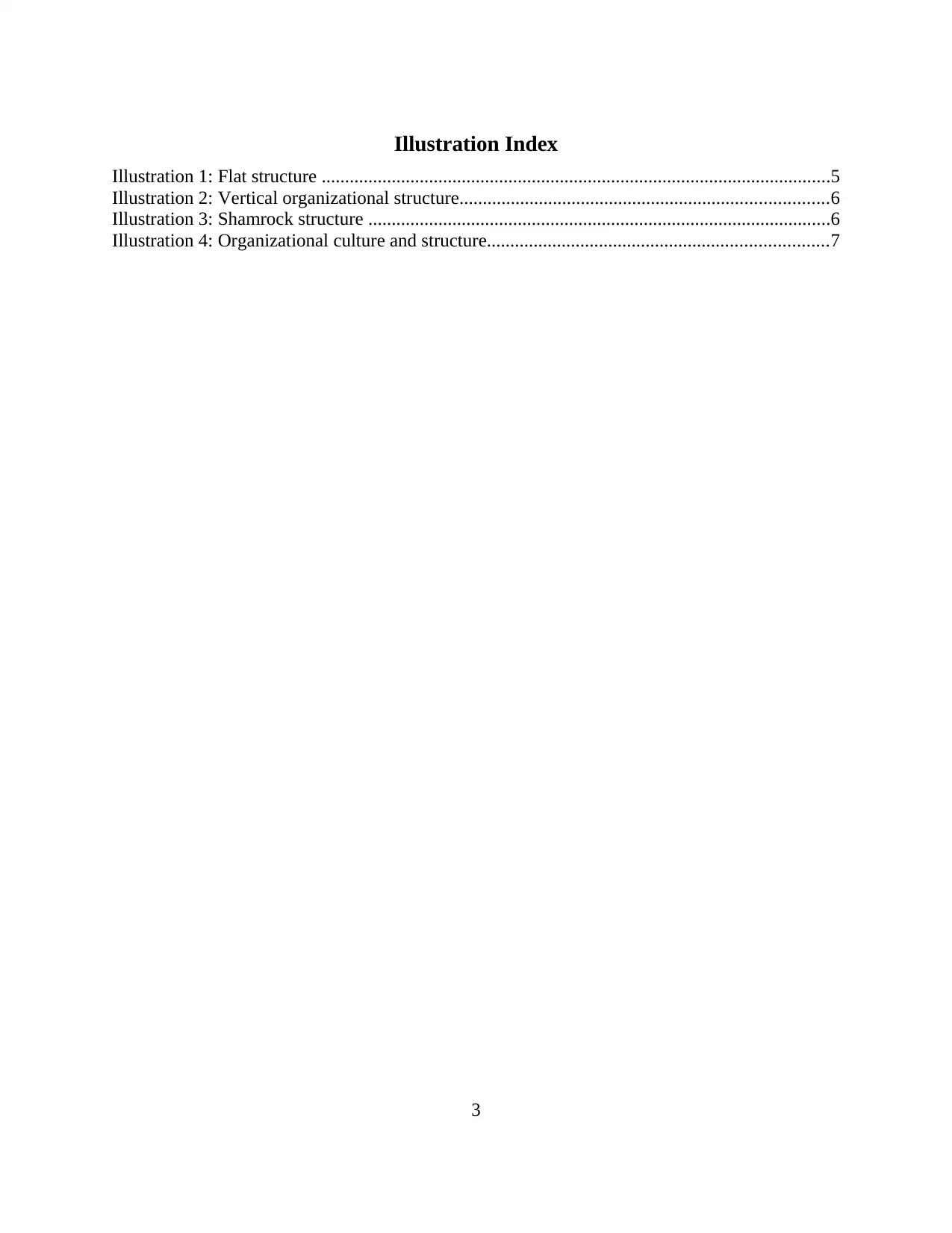
Illustration Index
Illustration 1: Flat structure .............................................................................................................5
Illustration 2: Vertical organizational structure...............................................................................6
Illustration 3: Shamrock structure ...................................................................................................6
Illustration 4: Organizational culture and structure.........................................................................7
3
Illustration 1: Flat structure .............................................................................................................5
Illustration 2: Vertical organizational structure...............................................................................6
Illustration 3: Shamrock structure ...................................................................................................6
Illustration 4: Organizational culture and structure.........................................................................7
3
⊘ This is a preview!⊘
Do you want full access?
Subscribe today to unlock all pages.

Trusted by 1+ million students worldwide
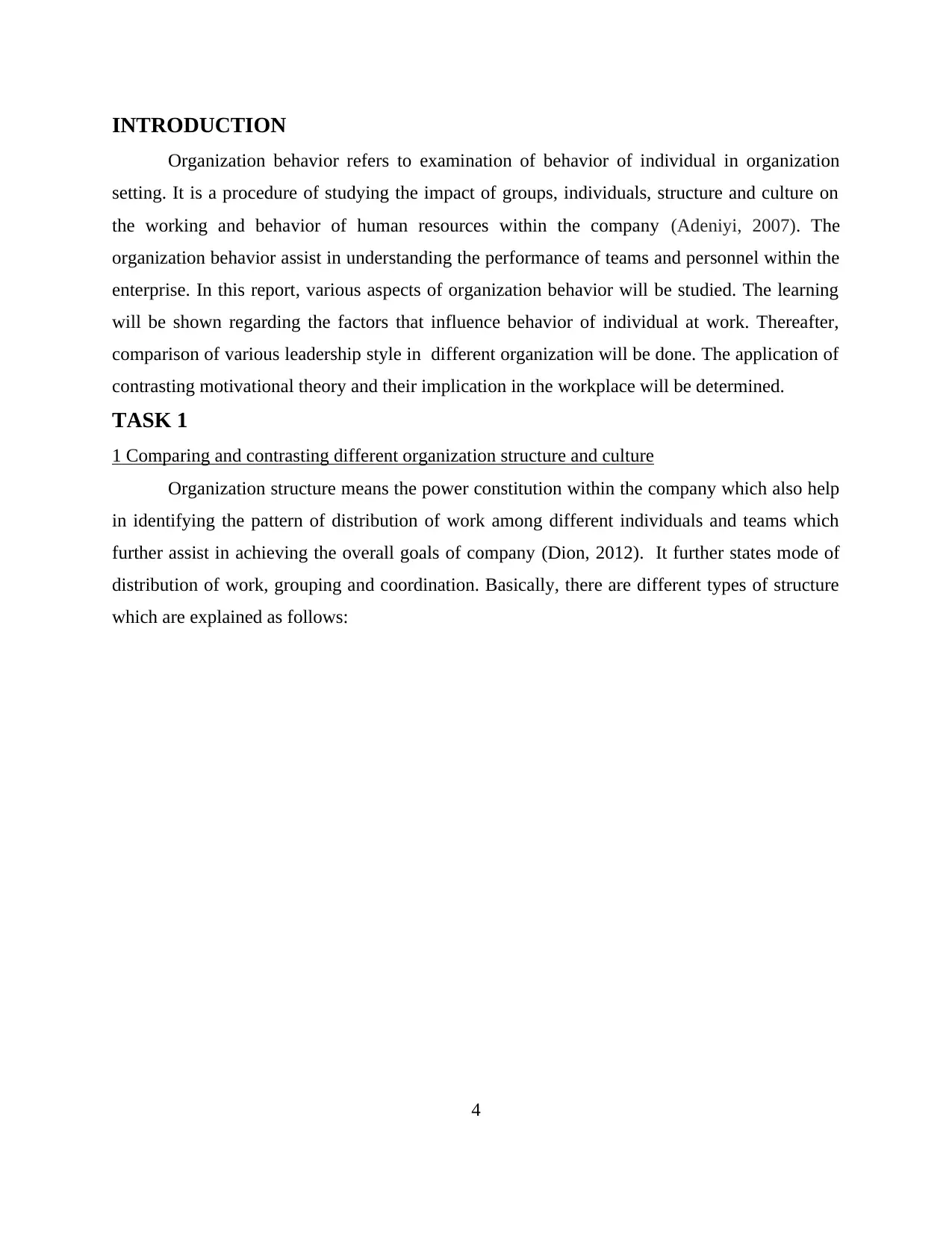
INTRODUCTION
Organization behavior refers to examination of behavior of individual in organization
setting. It is a procedure of studying the impact of groups, individuals, structure and culture on
the working and behavior of human resources within the company (Adeniyi, 2007). The
organization behavior assist in understanding the performance of teams and personnel within the
enterprise. In this report, various aspects of organization behavior will be studied. The learning
will be shown regarding the factors that influence behavior of individual at work. Thereafter,
comparison of various leadership style in different organization will be done. The application of
contrasting motivational theory and their implication in the workplace will be determined.
TASK 1
1 Comparing and contrasting different organization structure and culture
Organization structure means the power constitution within the company which also help
in identifying the pattern of distribution of work among different individuals and teams which
further assist in achieving the overall goals of company (Dion, 2012). It further states mode of
distribution of work, grouping and coordination. Basically, there are different types of structure
which are explained as follows:
4
Organization behavior refers to examination of behavior of individual in organization
setting. It is a procedure of studying the impact of groups, individuals, structure and culture on
the working and behavior of human resources within the company (Adeniyi, 2007). The
organization behavior assist in understanding the performance of teams and personnel within the
enterprise. In this report, various aspects of organization behavior will be studied. The learning
will be shown regarding the factors that influence behavior of individual at work. Thereafter,
comparison of various leadership style in different organization will be done. The application of
contrasting motivational theory and their implication in the workplace will be determined.
TASK 1
1 Comparing and contrasting different organization structure and culture
Organization structure means the power constitution within the company which also help
in identifying the pattern of distribution of work among different individuals and teams which
further assist in achieving the overall goals of company (Dion, 2012). It further states mode of
distribution of work, grouping and coordination. Basically, there are different types of structure
which are explained as follows:
4
Paraphrase This Document
Need a fresh take? Get an instant paraphrase of this document with our AI Paraphraser
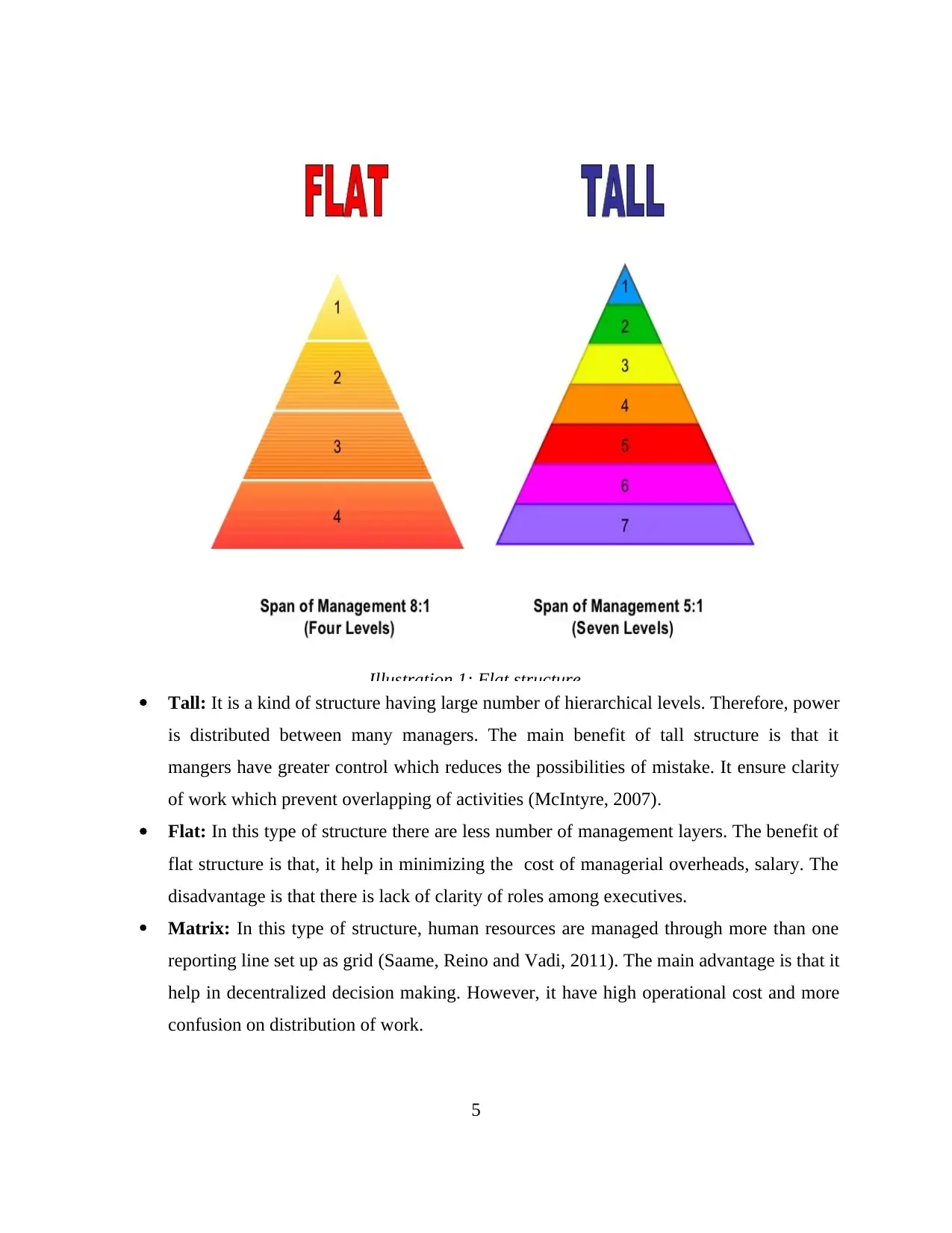
Tall: It is a kind of structure having large number of hierarchical levels. Therefore, power
is distributed between many managers. The main benefit of tall structure is that it
mangers have greater control which reduces the possibilities of mistake. It ensure clarity
of work which prevent overlapping of activities (McIntyre, 2007).
Flat: In this type of structure there are less number of management layers. The benefit of
flat structure is that, it help in minimizing the cost of managerial overheads, salary. The
disadvantage is that there is lack of clarity of roles among executives.
Matrix: In this type of structure, human resources are managed through more than one
reporting line set up as grid (Saame, Reino and Vadi, 2011). The main advantage is that it
help in decentralized decision making. However, it have high operational cost and more
confusion on distribution of work.
5
Illustration 1: Flat structure
is distributed between many managers. The main benefit of tall structure is that it
mangers have greater control which reduces the possibilities of mistake. It ensure clarity
of work which prevent overlapping of activities (McIntyre, 2007).
Flat: In this type of structure there are less number of management layers. The benefit of
flat structure is that, it help in minimizing the cost of managerial overheads, salary. The
disadvantage is that there is lack of clarity of roles among executives.
Matrix: In this type of structure, human resources are managed through more than one
reporting line set up as grid (Saame, Reino and Vadi, 2011). The main advantage is that it
help in decentralized decision making. However, it have high operational cost and more
confusion on distribution of work.
5
Illustration 1: Flat structure
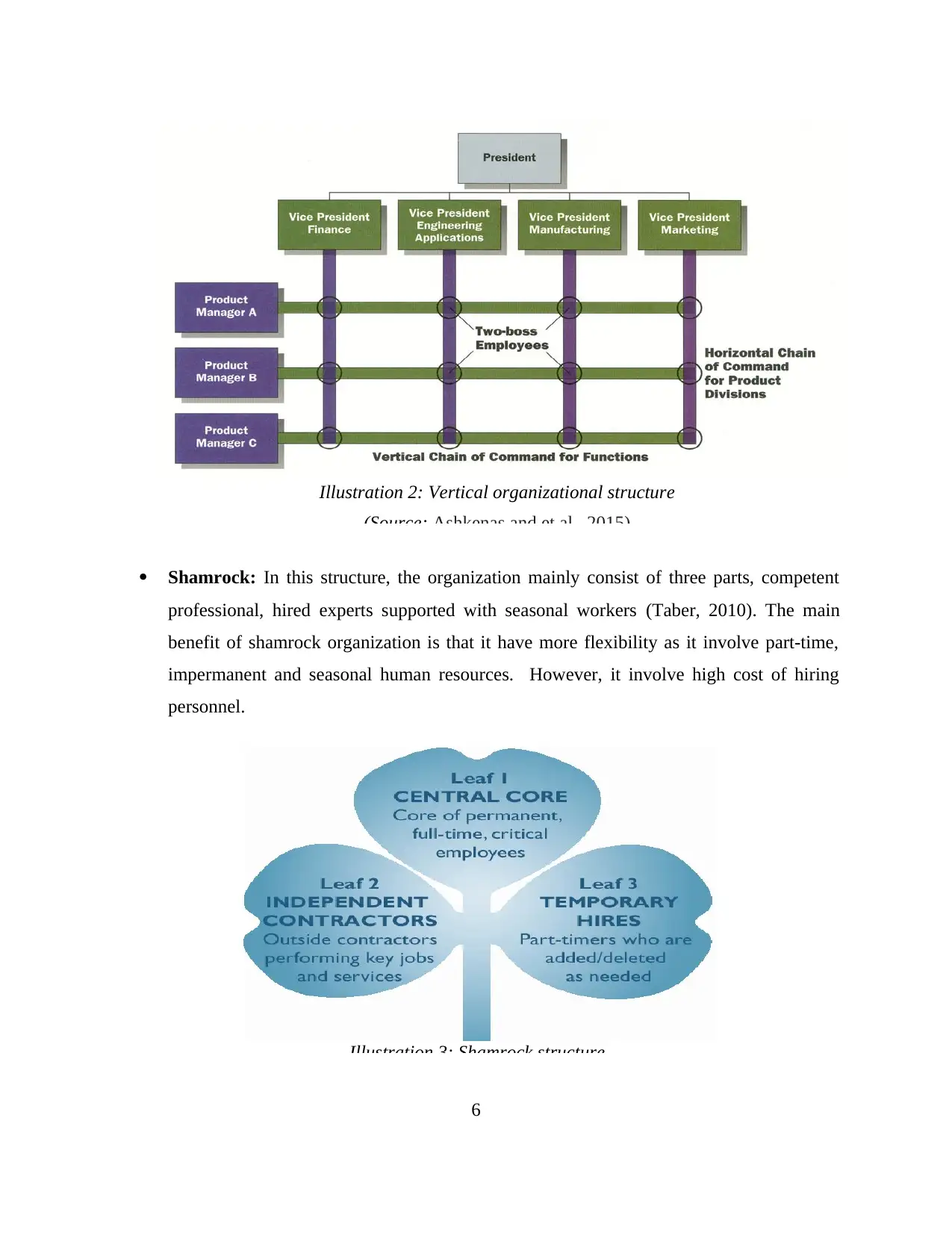
Shamrock: In this structure, the organization mainly consist of three parts, competent
professional, hired experts supported with seasonal workers (Taber, 2010). The main
benefit of shamrock organization is that it have more flexibility as it involve part-time,
impermanent and seasonal human resources. However, it involve high cost of hiring
personnel.
6
Illustration 2: Vertical organizational structure
(Source: Ashkenas and et.al., 2015)
Illustration 3: Shamrock structure
professional, hired experts supported with seasonal workers (Taber, 2010). The main
benefit of shamrock organization is that it have more flexibility as it involve part-time,
impermanent and seasonal human resources. However, it involve high cost of hiring
personnel.
6
Illustration 2: Vertical organizational structure
(Source: Ashkenas and et.al., 2015)
Illustration 3: Shamrock structure
⊘ This is a preview!⊘
Do you want full access?
Subscribe today to unlock all pages.

Trusted by 1+ million students worldwide
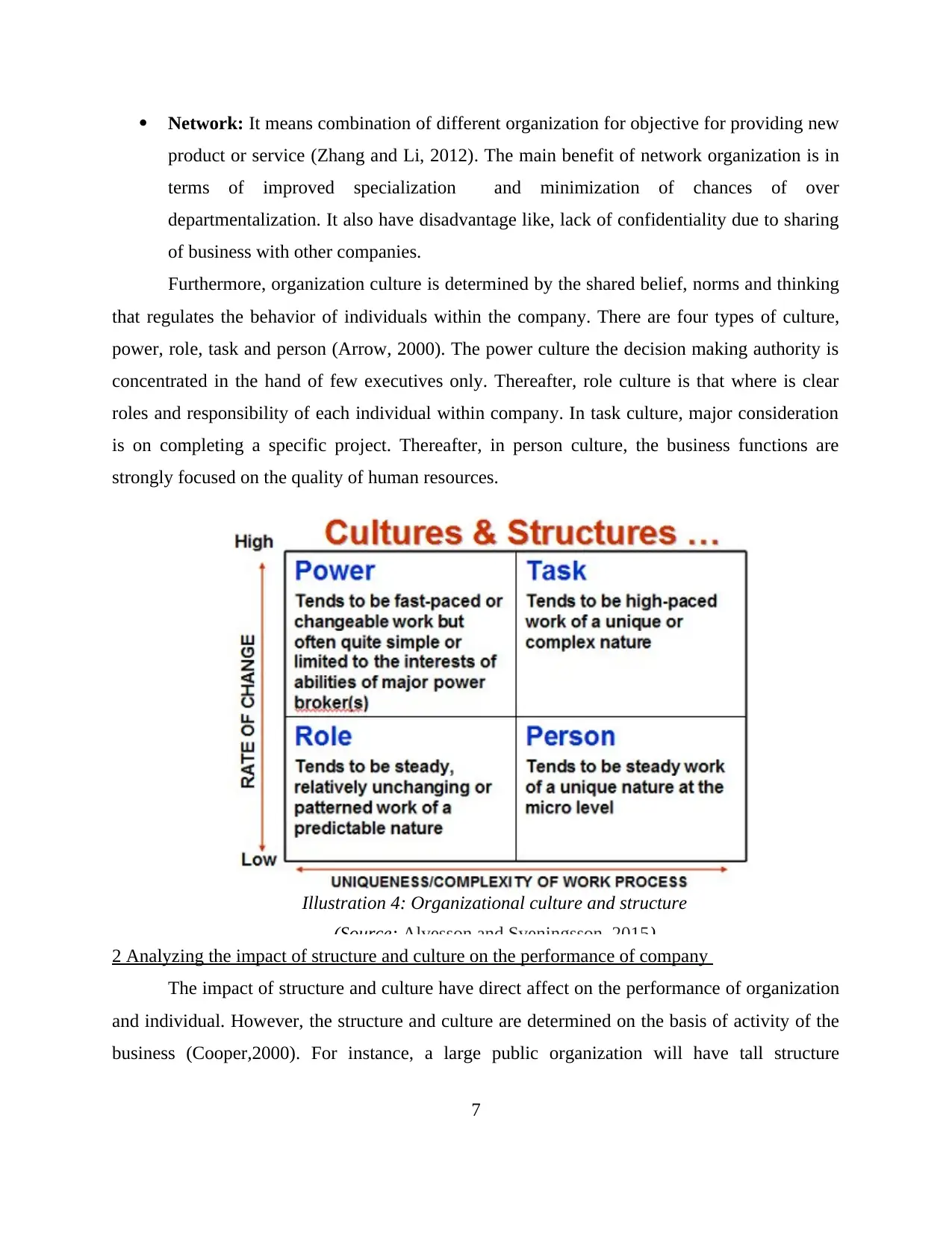
Network: It means combination of different organization for objective for providing new
product or service (Zhang and Li, 2012). The main benefit of network organization is in
terms of improved specialization and minimization of chances of over
departmentalization. It also have disadvantage like, lack of confidentiality due to sharing
of business with other companies.
Furthermore, organization culture is determined by the shared belief, norms and thinking
that regulates the behavior of individuals within the company. There are four types of culture,
power, role, task and person (Arrow, 2000). The power culture the decision making authority is
concentrated in the hand of few executives only. Thereafter, role culture is that where is clear
roles and responsibility of each individual within company. In task culture, major consideration
is on completing a specific project. Thereafter, in person culture, the business functions are
strongly focused on the quality of human resources.
2 Analyzing the impact of structure and culture on the performance of company
The impact of structure and culture have direct affect on the performance of organization
and individual. However, the structure and culture are determined on the basis of activity of the
business (Cooper,2000). For instance, a large public organization will have tall structure
7
Illustration 4: Organizational culture and structure
(Source: Alvesson and Sveningsson, 2015)
product or service (Zhang and Li, 2012). The main benefit of network organization is in
terms of improved specialization and minimization of chances of over
departmentalization. It also have disadvantage like, lack of confidentiality due to sharing
of business with other companies.
Furthermore, organization culture is determined by the shared belief, norms and thinking
that regulates the behavior of individuals within the company. There are four types of culture,
power, role, task and person (Arrow, 2000). The power culture the decision making authority is
concentrated in the hand of few executives only. Thereafter, role culture is that where is clear
roles and responsibility of each individual within company. In task culture, major consideration
is on completing a specific project. Thereafter, in person culture, the business functions are
strongly focused on the quality of human resources.
2 Analyzing the impact of structure and culture on the performance of company
The impact of structure and culture have direct affect on the performance of organization
and individual. However, the structure and culture are determined on the basis of activity of the
business (Cooper,2000). For instance, a large public organization will have tall structure
7
Illustration 4: Organizational culture and structure
(Source: Alvesson and Sveningsson, 2015)
Paraphrase This Document
Need a fresh take? Get an instant paraphrase of this document with our AI Paraphraser
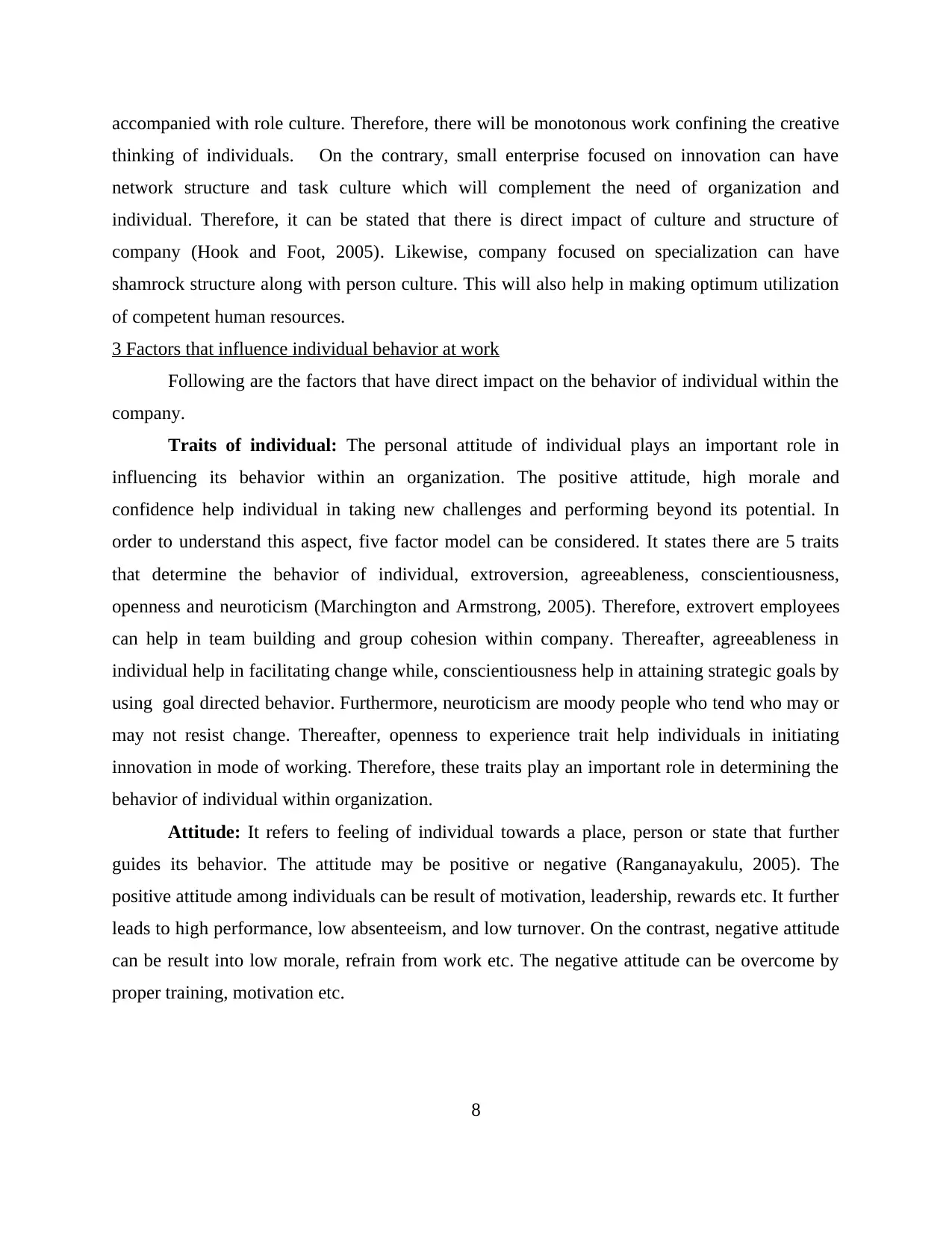
accompanied with role culture. Therefore, there will be monotonous work confining the creative
thinking of individuals. On the contrary, small enterprise focused on innovation can have
network structure and task culture which will complement the need of organization and
individual. Therefore, it can be stated that there is direct impact of culture and structure of
company (Hook and Foot, 2005). Likewise, company focused on specialization can have
shamrock structure along with person culture. This will also help in making optimum utilization
of competent human resources.
3 Factors that influence individual behavior at work
Following are the factors that have direct impact on the behavior of individual within the
company.
Traits of individual: The personal attitude of individual plays an important role in
influencing its behavior within an organization. The positive attitude, high morale and
confidence help individual in taking new challenges and performing beyond its potential. In
order to understand this aspect, five factor model can be considered. It states there are 5 traits
that determine the behavior of individual, extroversion, agreeableness, conscientiousness,
openness and neuroticism (Marchington and Armstrong, 2005). Therefore, extrovert employees
can help in team building and group cohesion within company. Thereafter, agreeableness in
individual help in facilitating change while, conscientiousness help in attaining strategic goals by
using goal directed behavior. Furthermore, neuroticism are moody people who tend who may or
may not resist change. Thereafter, openness to experience trait help individuals in initiating
innovation in mode of working. Therefore, these traits play an important role in determining the
behavior of individual within organization.
Attitude: It refers to feeling of individual towards a place, person or state that further
guides its behavior. The attitude may be positive or negative (Ranganayakulu, 2005). The
positive attitude among individuals can be result of motivation, leadership, rewards etc. It further
leads to high performance, low absenteeism, and low turnover. On the contrast, negative attitude
can be result into low morale, refrain from work etc. The negative attitude can be overcome by
proper training, motivation etc.
8
thinking of individuals. On the contrary, small enterprise focused on innovation can have
network structure and task culture which will complement the need of organization and
individual. Therefore, it can be stated that there is direct impact of culture and structure of
company (Hook and Foot, 2005). Likewise, company focused on specialization can have
shamrock structure along with person culture. This will also help in making optimum utilization
of competent human resources.
3 Factors that influence individual behavior at work
Following are the factors that have direct impact on the behavior of individual within the
company.
Traits of individual: The personal attitude of individual plays an important role in
influencing its behavior within an organization. The positive attitude, high morale and
confidence help individual in taking new challenges and performing beyond its potential. In
order to understand this aspect, five factor model can be considered. It states there are 5 traits
that determine the behavior of individual, extroversion, agreeableness, conscientiousness,
openness and neuroticism (Marchington and Armstrong, 2005). Therefore, extrovert employees
can help in team building and group cohesion within company. Thereafter, agreeableness in
individual help in facilitating change while, conscientiousness help in attaining strategic goals by
using goal directed behavior. Furthermore, neuroticism are moody people who tend who may or
may not resist change. Thereafter, openness to experience trait help individuals in initiating
innovation in mode of working. Therefore, these traits play an important role in determining the
behavior of individual within organization.
Attitude: It refers to feeling of individual towards a place, person or state that further
guides its behavior. The attitude may be positive or negative (Ranganayakulu, 2005). The
positive attitude among individuals can be result of motivation, leadership, rewards etc. It further
leads to high performance, low absenteeism, and low turnover. On the contrast, negative attitude
can be result into low morale, refrain from work etc. The negative attitude can be overcome by
proper training, motivation etc.
8
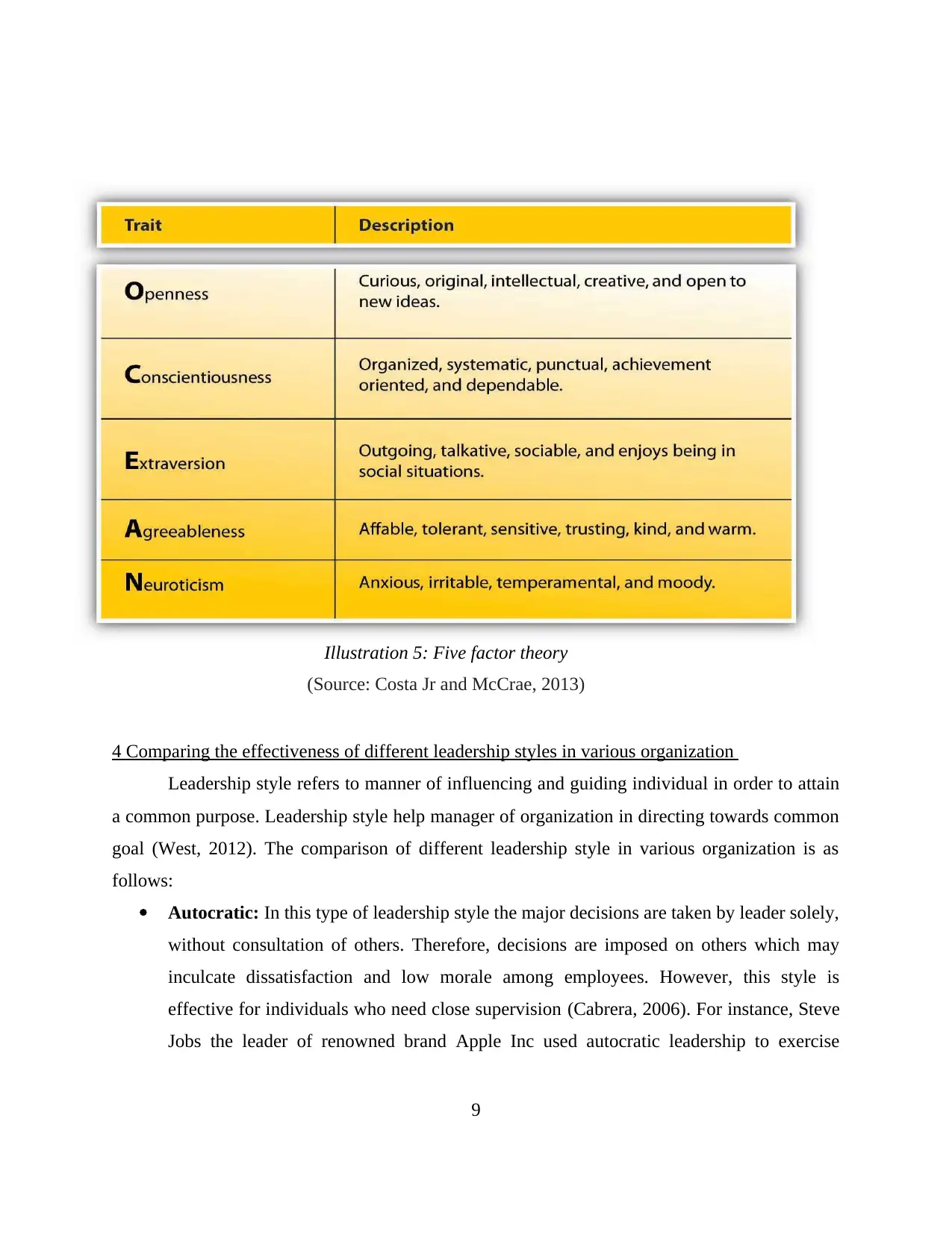
4 Comparing the effectiveness of different leadership styles in various organization
Leadership style refers to manner of influencing and guiding individual in order to attain
a common purpose. Leadership style help manager of organization in directing towards common
goal (West, 2012). The comparison of different leadership style in various organization is as
follows:
Autocratic: In this type of leadership style the major decisions are taken by leader solely,
without consultation of others. Therefore, decisions are imposed on others which may
inculcate dissatisfaction and low morale among employees. However, this style is
effective for individuals who need close supervision (Cabrera, 2006). For instance, Steve
Jobs the leader of renowned brand Apple Inc used autocratic leadership to exercise
9
Illustration 5: Five factor theory
(Source: Costa Jr and McCrae, 2013)
Leadership style refers to manner of influencing and guiding individual in order to attain
a common purpose. Leadership style help manager of organization in directing towards common
goal (West, 2012). The comparison of different leadership style in various organization is as
follows:
Autocratic: In this type of leadership style the major decisions are taken by leader solely,
without consultation of others. Therefore, decisions are imposed on others which may
inculcate dissatisfaction and low morale among employees. However, this style is
effective for individuals who need close supervision (Cabrera, 2006). For instance, Steve
Jobs the leader of renowned brand Apple Inc used autocratic leadership to exercise
9
Illustration 5: Five factor theory
(Source: Costa Jr and McCrae, 2013)
⊘ This is a preview!⊘
Do you want full access?
Subscribe today to unlock all pages.

Trusted by 1+ million students worldwide
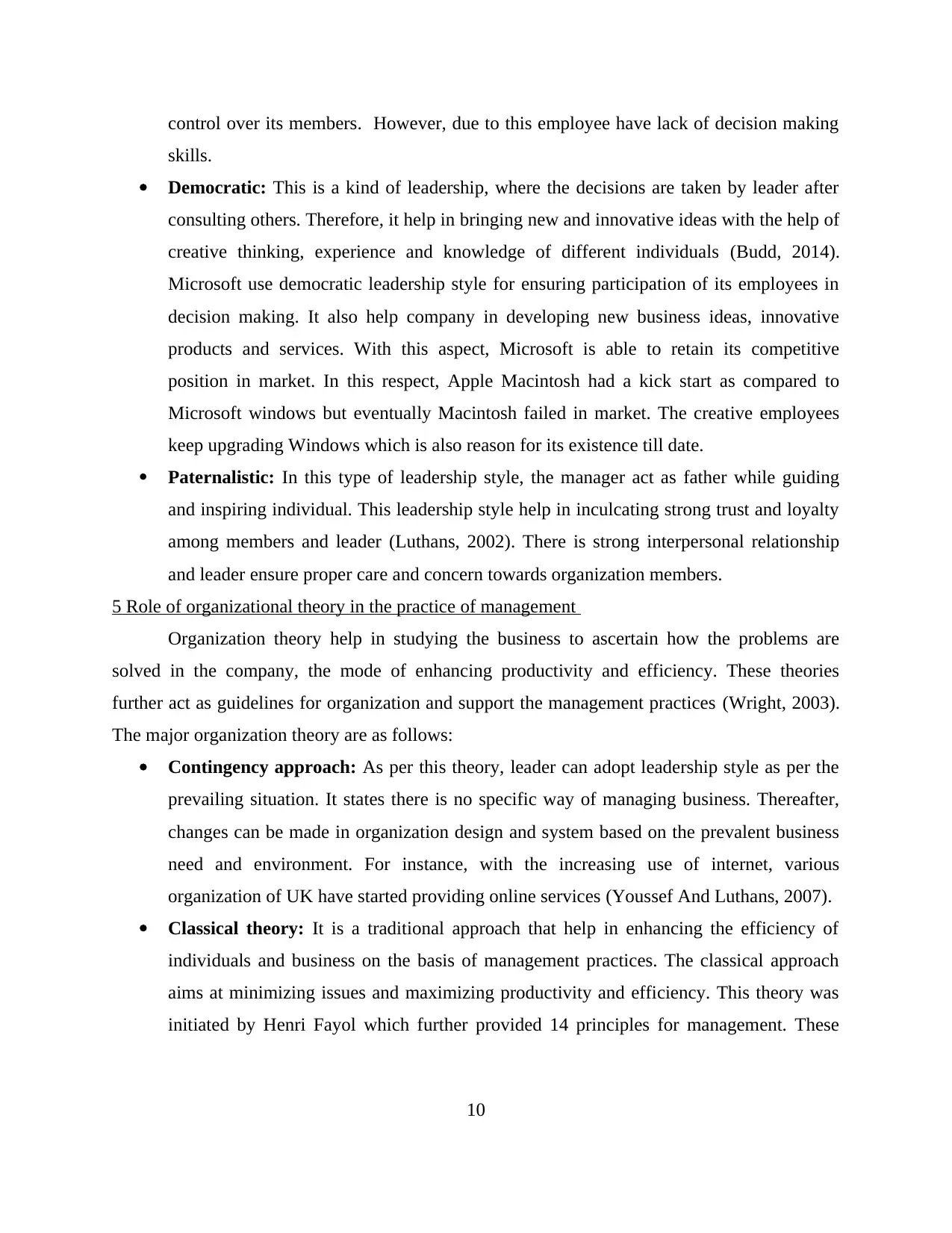
control over its members. However, due to this employee have lack of decision making
skills.
Democratic: This is a kind of leadership, where the decisions are taken by leader after
consulting others. Therefore, it help in bringing new and innovative ideas with the help of
creative thinking, experience and knowledge of different individuals (Budd, 2014).
Microsoft use democratic leadership style for ensuring participation of its employees in
decision making. It also help company in developing new business ideas, innovative
products and services. With this aspect, Microsoft is able to retain its competitive
position in market. In this respect, Apple Macintosh had a kick start as compared to
Microsoft windows but eventually Macintosh failed in market. The creative employees
keep upgrading Windows which is also reason for its existence till date.
Paternalistic: In this type of leadership style, the manager act as father while guiding
and inspiring individual. This leadership style help in inculcating strong trust and loyalty
among members and leader (Luthans, 2002). There is strong interpersonal relationship
and leader ensure proper care and concern towards organization members.
5 Role of organizational theory in the practice of management
Organization theory help in studying the business to ascertain how the problems are
solved in the company, the mode of enhancing productivity and efficiency. These theories
further act as guidelines for organization and support the management practices (Wright, 2003).
The major organization theory are as follows:
Contingency approach: As per this theory, leader can adopt leadership style as per the
prevailing situation. It states there is no specific way of managing business. Thereafter,
changes can be made in organization design and system based on the prevalent business
need and environment. For instance, with the increasing use of internet, various
organization of UK have started providing online services (Youssef And Luthans, 2007).
Classical theory: It is a traditional approach that help in enhancing the efficiency of
individuals and business on the basis of management practices. The classical approach
aims at minimizing issues and maximizing productivity and efficiency. This theory was
initiated by Henri Fayol which further provided 14 principles for management. These
10
skills.
Democratic: This is a kind of leadership, where the decisions are taken by leader after
consulting others. Therefore, it help in bringing new and innovative ideas with the help of
creative thinking, experience and knowledge of different individuals (Budd, 2014).
Microsoft use democratic leadership style for ensuring participation of its employees in
decision making. It also help company in developing new business ideas, innovative
products and services. With this aspect, Microsoft is able to retain its competitive
position in market. In this respect, Apple Macintosh had a kick start as compared to
Microsoft windows but eventually Macintosh failed in market. The creative employees
keep upgrading Windows which is also reason for its existence till date.
Paternalistic: In this type of leadership style, the manager act as father while guiding
and inspiring individual. This leadership style help in inculcating strong trust and loyalty
among members and leader (Luthans, 2002). There is strong interpersonal relationship
and leader ensure proper care and concern towards organization members.
5 Role of organizational theory in the practice of management
Organization theory help in studying the business to ascertain how the problems are
solved in the company, the mode of enhancing productivity and efficiency. These theories
further act as guidelines for organization and support the management practices (Wright, 2003).
The major organization theory are as follows:
Contingency approach: As per this theory, leader can adopt leadership style as per the
prevailing situation. It states there is no specific way of managing business. Thereafter,
changes can be made in organization design and system based on the prevalent business
need and environment. For instance, with the increasing use of internet, various
organization of UK have started providing online services (Youssef And Luthans, 2007).
Classical theory: It is a traditional approach that help in enhancing the efficiency of
individuals and business on the basis of management practices. The classical approach
aims at minimizing issues and maximizing productivity and efficiency. This theory was
initiated by Henri Fayol which further provided 14 principles for management. These
10
Paraphrase This Document
Need a fresh take? Get an instant paraphrase of this document with our AI Paraphraser
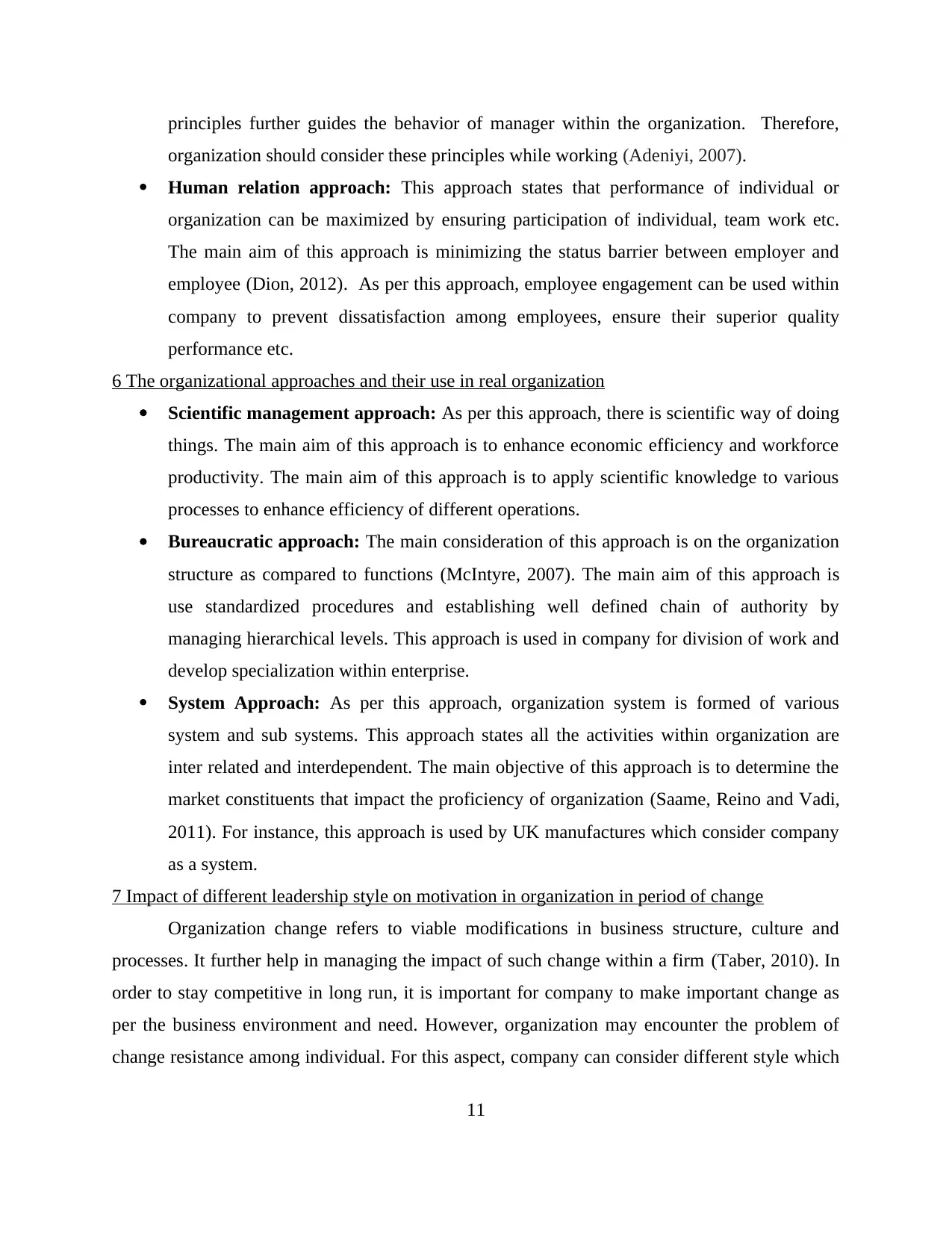
principles further guides the behavior of manager within the organization. Therefore,
organization should consider these principles while working (Adeniyi, 2007).
Human relation approach: This approach states that performance of individual or
organization can be maximized by ensuring participation of individual, team work etc.
The main aim of this approach is minimizing the status barrier between employer and
employee (Dion, 2012). As per this approach, employee engagement can be used within
company to prevent dissatisfaction among employees, ensure their superior quality
performance etc.
6 The organizational approaches and their use in real organization
Scientific management approach: As per this approach, there is scientific way of doing
things. The main aim of this approach is to enhance economic efficiency and workforce
productivity. The main aim of this approach is to apply scientific knowledge to various
processes to enhance efficiency of different operations.
Bureaucratic approach: The main consideration of this approach is on the organization
structure as compared to functions (McIntyre, 2007). The main aim of this approach is
use standardized procedures and establishing well defined chain of authority by
managing hierarchical levels. This approach is used in company for division of work and
develop specialization within enterprise.
System Approach: As per this approach, organization system is formed of various
system and sub systems. This approach states all the activities within organization are
inter related and interdependent. The main objective of this approach is to determine the
market constituents that impact the proficiency of organization (Saame, Reino and Vadi,
2011). For instance, this approach is used by UK manufactures which consider company
as a system.
7 Impact of different leadership style on motivation in organization in period of change
Organization change refers to viable modifications in business structure, culture and
processes. It further help in managing the impact of such change within a firm (Taber, 2010). In
order to stay competitive in long run, it is important for company to make important change as
per the business environment and need. However, organization may encounter the problem of
change resistance among individual. For this aspect, company can consider different style which
11
organization should consider these principles while working (Adeniyi, 2007).
Human relation approach: This approach states that performance of individual or
organization can be maximized by ensuring participation of individual, team work etc.
The main aim of this approach is minimizing the status barrier between employer and
employee (Dion, 2012). As per this approach, employee engagement can be used within
company to prevent dissatisfaction among employees, ensure their superior quality
performance etc.
6 The organizational approaches and their use in real organization
Scientific management approach: As per this approach, there is scientific way of doing
things. The main aim of this approach is to enhance economic efficiency and workforce
productivity. The main aim of this approach is to apply scientific knowledge to various
processes to enhance efficiency of different operations.
Bureaucratic approach: The main consideration of this approach is on the organization
structure as compared to functions (McIntyre, 2007). The main aim of this approach is
use standardized procedures and establishing well defined chain of authority by
managing hierarchical levels. This approach is used in company for division of work and
develop specialization within enterprise.
System Approach: As per this approach, organization system is formed of various
system and sub systems. This approach states all the activities within organization are
inter related and interdependent. The main objective of this approach is to determine the
market constituents that impact the proficiency of organization (Saame, Reino and Vadi,
2011). For instance, this approach is used by UK manufactures which consider company
as a system.
7 Impact of different leadership style on motivation in organization in period of change
Organization change refers to viable modifications in business structure, culture and
processes. It further help in managing the impact of such change within a firm (Taber, 2010). In
order to stay competitive in long run, it is important for company to make important change as
per the business environment and need. However, organization may encounter the problem of
change resistance among individual. For this aspect, company can consider different style which
11
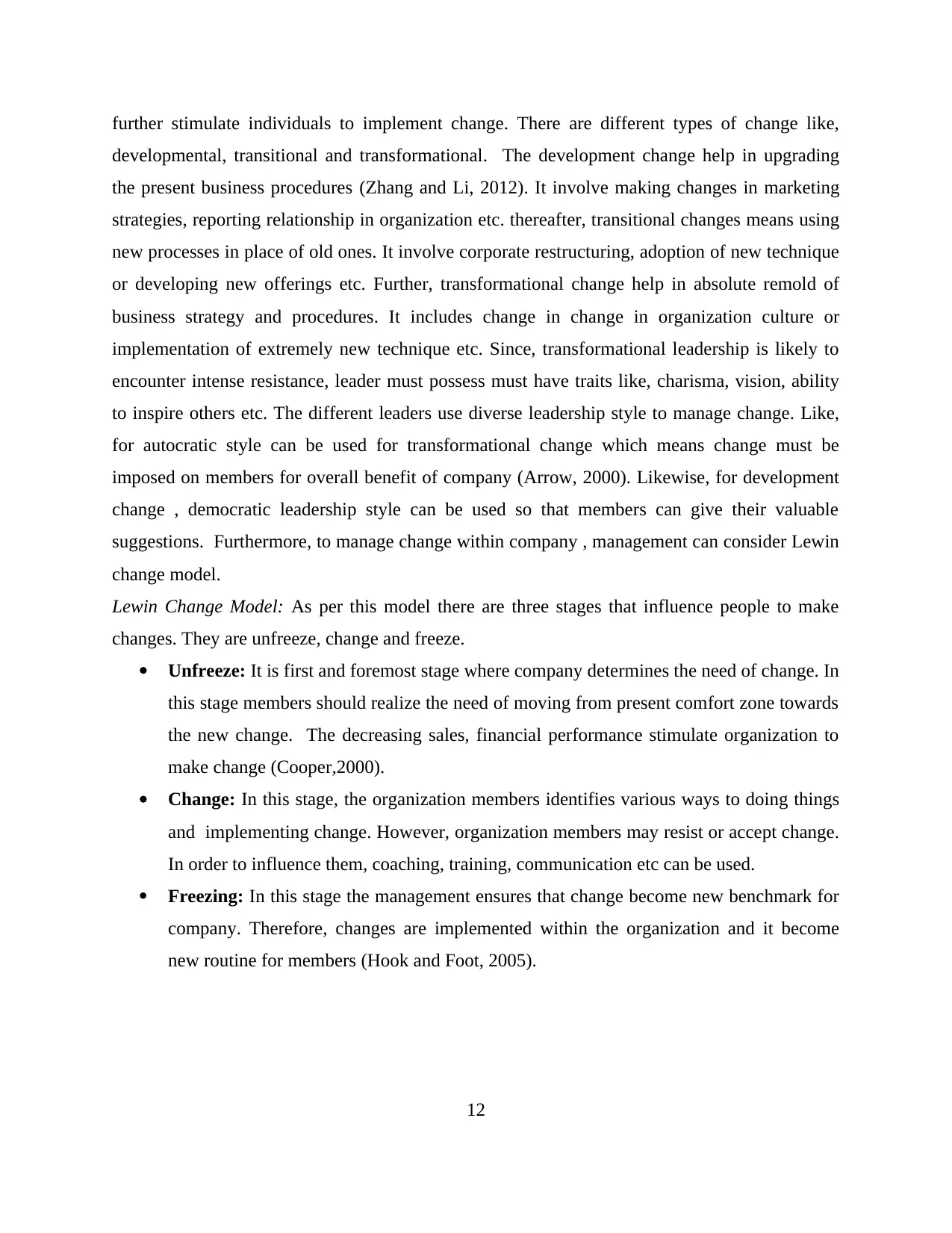
further stimulate individuals to implement change. There are different types of change like,
developmental, transitional and transformational. The development change help in upgrading
the present business procedures (Zhang and Li, 2012). It involve making changes in marketing
strategies, reporting relationship in organization etc. thereafter, transitional changes means using
new processes in place of old ones. It involve corporate restructuring, adoption of new technique
or developing new offerings etc. Further, transformational change help in absolute remold of
business strategy and procedures. It includes change in change in organization culture or
implementation of extremely new technique etc. Since, transformational leadership is likely to
encounter intense resistance, leader must possess must have traits like, charisma, vision, ability
to inspire others etc. The different leaders use diverse leadership style to manage change. Like,
for autocratic style can be used for transformational change which means change must be
imposed on members for overall benefit of company (Arrow, 2000). Likewise, for development
change , democratic leadership style can be used so that members can give their valuable
suggestions. Furthermore, to manage change within company , management can consider Lewin
change model.
Lewin Change Model: As per this model there are three stages that influence people to make
changes. They are unfreeze, change and freeze.
Unfreeze: It is first and foremost stage where company determines the need of change. In
this stage members should realize the need of moving from present comfort zone towards
the new change. The decreasing sales, financial performance stimulate organization to
make change (Cooper,2000).
Change: In this stage, the organization members identifies various ways to doing things
and implementing change. However, organization members may resist or accept change.
In order to influence them, coaching, training, communication etc can be used.
Freezing: In this stage the management ensures that change become new benchmark for
company. Therefore, changes are implemented within the organization and it become
new routine for members (Hook and Foot, 2005).
12
developmental, transitional and transformational. The development change help in upgrading
the present business procedures (Zhang and Li, 2012). It involve making changes in marketing
strategies, reporting relationship in organization etc. thereafter, transitional changes means using
new processes in place of old ones. It involve corporate restructuring, adoption of new technique
or developing new offerings etc. Further, transformational change help in absolute remold of
business strategy and procedures. It includes change in change in organization culture or
implementation of extremely new technique etc. Since, transformational leadership is likely to
encounter intense resistance, leader must possess must have traits like, charisma, vision, ability
to inspire others etc. The different leaders use diverse leadership style to manage change. Like,
for autocratic style can be used for transformational change which means change must be
imposed on members for overall benefit of company (Arrow, 2000). Likewise, for development
change , democratic leadership style can be used so that members can give their valuable
suggestions. Furthermore, to manage change within company , management can consider Lewin
change model.
Lewin Change Model: As per this model there are three stages that influence people to make
changes. They are unfreeze, change and freeze.
Unfreeze: It is first and foremost stage where company determines the need of change. In
this stage members should realize the need of moving from present comfort zone towards
the new change. The decreasing sales, financial performance stimulate organization to
make change (Cooper,2000).
Change: In this stage, the organization members identifies various ways to doing things
and implementing change. However, organization members may resist or accept change.
In order to influence them, coaching, training, communication etc can be used.
Freezing: In this stage the management ensures that change become new benchmark for
company. Therefore, changes are implemented within the organization and it become
new routine for members (Hook and Foot, 2005).
12
⊘ This is a preview!⊘
Do you want full access?
Subscribe today to unlock all pages.

Trusted by 1+ million students worldwide
1 out of 17
Related Documents
Your All-in-One AI-Powered Toolkit for Academic Success.
+13062052269
info@desklib.com
Available 24*7 on WhatsApp / Email
![[object Object]](/_next/static/media/star-bottom.7253800d.svg)
Unlock your academic potential
Copyright © 2020–2025 A2Z Services. All Rights Reserved. Developed and managed by ZUCOL.





